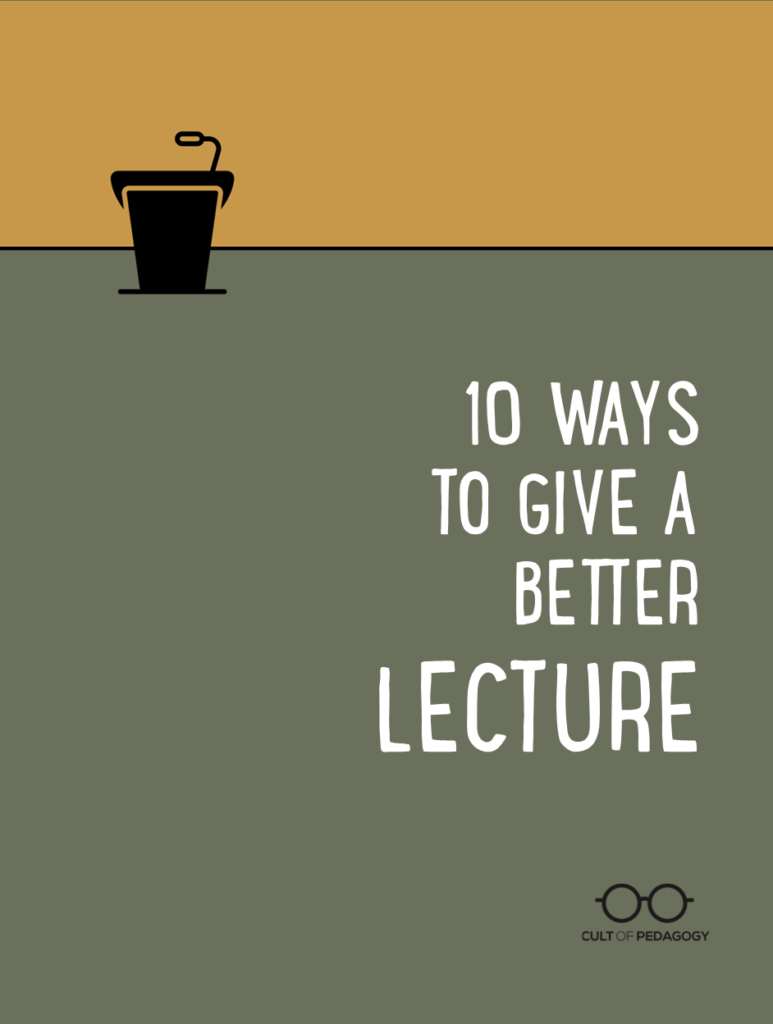
Listen to this post as a podcast:
Sponsored by EVERFI and Hapara
This page contains Bookshop.org links. When you make a purchase through these links, Cult of Pedagogy gets a small percentage of the sale at no extra cost to you. What’s the difference between Amazon and Bookshop.org?
It would be an understatement to say that lecturing is frowned upon in modern teaching. At this point it’s almost become a cliché: Don’t be the sage on the stage; be the guide on the side. Ideally, we should stick to supporting students through inquiry learning, cooperative learning, project-based learning, and so on. I have personally advocated for ALL of these approaches, over and over again. And I do believe that students need to be active in their learning.
But does that mean we dump lectures altogether? At a time when TED Talks and online courses are incredibly popular, when our students get at least some portion of their instruction through video-based, blended learning platforms, and when most people reading this have probably learned something useful or interesting in the last month from YouTube, aren’t we all learning from lectures all the time?
I’d argue that two factors have given lectures a bad name: overuse and poor execution. Let’s look at these issues one at a time.
Using Lectures with Intention
The first problem with lecture as a teaching strategy is overuse: If a course is built entirely on lecture, if every class meeting is a solid block of the teacher talking nonstop, students will dread going to class. But if lecture is just one of many different strategies we use to design learning experiences for students, students are more likely to look forward to those experiences. The key is choosing a lecture intentionally to meet certain learning goals.
So what are those goals? What are good reasons to choose a lecture over some other method?
In his post, In Defense of Lecture in the Classroom, high school psychology teacher Blake Harvard advocates for the lecture’s simplicity and straightforwardness. “Lecture imparts knowledge,” he writes. “Knowledge is a requirement for innovation and creativity. Simply put, you cannot be creative with knowledge you do not have. This is why, when initially presenting information to students, I try to do so in as simple a method as possible. Creating an environment with as few distractions as possible decreases the extraneous load on our limited working memory and allows for the possible processing of more material.”
When considering whether a lecture might be the right choice for a particular lesson, this resource from the University of Tennessee offers some guidelines. It advises that lecture is a good fit when:
- The background information is not available or accessible to students
- The content may be confusing (and therefore need explanation)
- The teacher’s expertise will help make the material more clear
- The material needs to be delivered quickly
I would think of it this way: If you have a chunk of material that students need to know in order to do something more higher-order with it, would it make more sense to have them slowly discover that information on their own through some kind of inquiry project, or is it more of a priority for them to learn that material pretty quickly so they can apply it in a higher-order task?
There is no one right answer here; the best way to determine if a lecture is the best option is to test it out yourself, with your students. Teach one chunk of your material in a lecture and another through some other method, like a reading, a constructivist activity like concept attainment, or a project-based task. Then see which method resulted in the most enduring learning. Or, if you teach several sections of the same class, use different methods in different sections and see what works best.
Ways to Improve a Lecture
The other factor that has made lectures taboo is poor execution. If an instructor does nothing but drone on and on in the style of Ben Stein in Ferris Bueller’s Day Off, then students will disengage quickly and very little learning will happen.
So along with using lectures more selectively, we need to make sure the lectures we do give are good.
As I regularly do when looking for classroom practices that work, I went out in search of the best ideas on lecturing from classroom teachers on Twitter. The best suggestions that came in are summarized here.
1. Give it Structure
Even if a lecture isn’t particularly exciting, it’s important to make it easy to follow. Do this by giving your presentation a clear structure and communicating that structure to your students.
A good place to start is by looking at the most common text structures for informational writing; even though your final product isn’t in print, you’re still basically creating a text. The structures are compare/contrast, cause and effect, problem/solution, definition or description, and sequence. The content you want to teach will probably fit nicely into one of these frameworks, and if you plan and deliver it that way, you’ll be more likely to give a lecture that makes sense.
Once you have the basic structure in place, preface it with a brief introduction where you preview the main points of the lecture to show where you’re headed.
And if you really want to polish it, add a creative anticipatory set to grab students’ attention at the beginning: a brief anecdote, an interesting quote, a thought-provoking image or question, anything to grab students’ attention and get them curious about the lesson.
2. Keep it Brief
Attention spans are short, so to keep your students engaged, don’t talk for more than a few minutes at a time. This can be accomplished by only planning a short lecture to begin with — recommendations range from 5 to 10 minutes — or breaking up a longer lecture into shorter chunks, with interactivity in between those chunks.
3. Engage Your Audience
In between those short stretches of teacher talk, you can do all kinds of things to get students participating:
- Whole-class polls can be done electronically with a tool like Poll Everywhere. You simply ask students a question related to the content — either a question to check their comprehension, an opinion question, or something that asks them to contribute an idea — and within seconds the responses can be displayed on a classroom screen, offering a starting point for discussion. If you’d rather not mess with tech, you can just as easily ask for a show of hands in response to a question, or do something more active like a quick This or That activity, where students move to one side of the room or the other based on their answer to a question.
- Discussion can be plugged in between lecture segments. In pairs or small groups, students can respond to questions that ask them to reflect, brainstorm, or expand on what’s being presented in the lecture.
- Student engagement platforms like Nearpod and Pear Deck allow you to add interactive elements into your slideshow and share them with students so they can respond to questions right inside the presentation and you can see their responses on your own screen.
These breaks serve more than one purpose: Yes, they offer variety and keep students engaged, and they can also serve as assessment opportunities. As you listen to and observe how students respond to these prompts, you can gauge how well they are understanding the material and make adjustments to your instruction as needed.
In addition to these activities in between lecture chunks, you can also keep students engaged during the lecture by having them take notes and encouraging them to doodle or draw while you talk. If you’re skeptical about whether note-taking is worth it, read through our summary of the research on note taking, then look at this fantastic strategy for teaching students how to take notes.
4. Use Visuals
Adding some kind of meaningful visuals to support your lecture will help students understand and remember what you teach. In fact, I’d go so far as to say that a lecture without any visual support — unless it’s simply for inspiration, like a TED Talk — will not be effective. People just learn better when words are combined with images; this is the theory of dual coding, and it’s supported by decades of research (Cuevas, 2016).
Your visuals can be any combination of charts, graphs, photos, or physical models. But we’re not talking about decoration here; they have to contribute to student understanding of the material. Oftentimes, this can be accomplished with a simple graphic organizer to show the relationships between concepts.
If the visuals you’re using are complex, it may also make sense to let students watch you create them piece by piece, rather than present their finished form on a slide. English teacher Andy Tharby, author of the book How to Explain Absolutely Anything to Absolutely Anyone, recommends using the board to build these kinds of visuals: “Your notes, squiggles, arrows and diagrams are an open, incremental narrative. They have been produced bit by bit and so not only do they model your thinking processes, but they also allow students to look back at previous steps if they lose track, zone out for a moment or two, forget something or cannot hold everything at once in their working memories.”
But slides are a perfectly good way to add visuals to a presentation, if you do them well. Our post Let’s Make Better Slideshows is dedicated entirely to specific principles you can follow to do just that.
5. Use Examples
You can explain something till you’re blue in the face, but until you provide an example of a concept, your students are much less likely to really get it. And more is better on this one, because as students are exposed to different examples of the same idea, their understanding gets more refined.
When she helps Ph.D. students prepare to present their research in lectures, Stanford lecturer Kelly McGonigal advises them to “talk about crunchy details, not abstractions. I don’t want to know that you study the technological interface of emotions and artificial intelligence in market analysis of [blah] — like basically a string of nouns. Point to something that you actually study, like, for example, a dating app. And what problem are you trying to solve, how to get people better matches or something like that…show me the actual thing.” So keep looking for opportunities to add crunchy details to your own lecture.
6. Use Analogies
Along with examples, analogies can make an abstract idea come to life. Comparing some new thing they’re learning to a thing they already know can often be the fastest way to help students understand something. This article by Andy Tharby offers a big list of different kinds of analogies you can use to make sense of things. Here’s just one: “Using the same sentence structure repetitively is the writing equivalent of munching on boiled cauliflower, and nothing else, for the rest of your life.”
7. Tell Stories
Many of the teachers who responded to my tweet cited storytelling as a key element of a good lecture. Public speaking experts like Carmine Gallo in his books Talk Like TED and The Presentation Secrets of Steve Jobs include storytelling as an essential tool of good speakers.
The power of story is backed by research. Stories create new mental images and strong emotional responses in listeners, and they provide a familiar, non-threatening way to ease students into learning (Green, 2004). Listening to stories activates parts of the brain that are unresponsive when taking in non-narrative content (Weldon, 2014). And incorporating stories or “storifying” our content is a recommended approach for making our instruction more culturally responsive, because it reflects the way many other cultures pass important information from generation to generation (Hammond, 2015).
So whenever you can include a captivating story as a way to teach some part of your content, do it.
8. Think Out Loud
As you give a lecture, it can be incredibly helpful if you verbalize your thinking process along the way. This is especially true if you are demonstrating some kind of process or skill, like solving a math problem or drafting a piece of writing, but it even works when you’re explaining a set of facts. If you come to a place that is often confusing to students or that even confused you once upon a time, take the opportunity to share that confusion with students; it will not just clear up their misunderstanding, but it will also reassure them that feeling uncertain is a normal part of the learning process.
9. Make it Dynamic
You’ll hold students’ attention better if you make a concerted effort to mix things up. To emphasize a point, pause, lower your voice dramatically, or go up sharply in volume. Add physical interest by moving to different parts of the room while you speak, using memorable gestures to accompany certain points, or just being more expressive with your face. Activate emotions by inserting humor, personal details, or weird or surprising facts. And plan these moments: Instead of just generally aiming for a more dynamic presentation, actually mark places in your lecture notes where you plan to include these elements.
10. Move it to the End
Lectures typically deliver what we call the direct instruction piece of a lesson, the part where we are directly teaching our students something. And in a traditional lesson, that direct instruction happens at the beginning: We teach our students something, then they do something to apply the knowledge they just got.
If we move things around — giving our students an opportunity to wrestle with the content a little bit first, then providing some direct instruction through a lecture — we stimulate their curiosity, get them thinking about the material more deeply, and create a context in which to fit the information they are about to learn. Then when we begin the lecture, students are much more invested in it.
This was one of the tips Norman Eng gave to college teachers for improving their instruction in 5 Ways College Teachers Can Improve Instruction. He recommends teachers start class with a discussion, question, challenge, or activity that connects to the content, then move into a lecture.
Sometimes the “wrestling” students do can actually become the lecture. On the Twitter thread, math teacher Will Dunn described how he starts his classes by presenting a problem to the whole group, then has students work on their own similar problems in small groups. Rotating among the groups, Dunn finds noteworthy examples from student work and uses those examples in a subsequent lecture.
The Right Tool at the Right Time
There is a lot of value in a well-planned, well-executed lecture. Just be intentional about it. Don’t spend whole class periods lecturing. Don’t lecture every single day. Don’t use the same gimmick over and over again so it feels stale.
What’s so lovely about this work is that it truly is a craft that can be honed over time, and part of becoming masters of our craft is knowing when to use the right tool at the right time. Instead of reducing our work to a set of absolutes, let’s treat teaching like the art form it is.
References
Cuevas, J. (2016). An analysis of current evidence supporting two alternate learning models: learning styles and dual coding. Journal of Educational Sciences and Psychology, 6(1). [PDF]
Green, M. C. (2004). Storytelling in teaching. Association for Psychological Science. https://www.psychologicalscience.org/observer/storytelling-in-teaching
Hammond, Z. (2015). Culturally responsive teaching and the brain: Promoting authentic engagement and rigor among culturally and linguistically diverse students. Thousand Oaks, CA: Corwin, a SAGE Company. (Amazon | Bookshop.org)
Weldon, M. (2014, April 22). Your brain on story: Why narratives win our hearts and minds. Pacific Standard. https://psmag.com/social-justice/pulitzer-prizes-journalism-reporting-your-brain-on-story-why-narratives-win-our-hearts-and-minds-79824
Join our mailing list and get weekly tips, tools, and inspiration that will make your teaching more effective and fun. You’ll get access to our members-only library of free downloads, including 20 Ways to Cut Your Grading Time in Half, the e-booklet that has helped thousands of teachers save time on grading. Over 50,000 teachers have already joined—come on in.





This is an excellent article. I see many of these same practices in quality direct instruction and explicit instruction. Thank you for sharing.
Jennifer – great post – I agree that there is still a need for “lecture” – direct instruction to happen in the context of a class. I just think that it is a better use of time for a teacher to flip their direct instruction so that class time is reserved for students to wrestle with the hard material. That said and I still “lecture” – though I call it a preview in my flipped-mastery classroom. I recently wrote a piece about why I still lecture in my flipped classrooms. It explains what I do in greater detail. https://intrepidednews.com/the-value-of-lecturing-in-a-flipped-classroom-jon-bergmann/
Thank you, Jennifer! I find myself very reliant on lecture, especially in the high school classroom (Social Studies). I will be implementing some of these strategies in my teaching!
We’d love to hear how it goes for you, Maddy!
Thank you for this very helpful process to plan effective lectures. I can’t remember the other episodes #s you recommended for effective note taking, etc. Would you be able to post the links?
April, if you scroll up to the sections of this post where Jenn references each resource, those episodes are actually hyperlinked directly in the post. Hope this helps!
Thank you for this article! I’m going to start student teaching next semester and I loved all of the ideas your presented to make lectures interesting and effective for our students. I particularly liked how you talked about giving your lecture a structure like you would any other text. I wonder if sometimes talking to our students about how we organize our lectures could even help them learn more about text structures? Anyways, I’m excited to try some of these strategies!
Great point, Rebecca- we can model text structures, analogies, literary devices and more through lecture. Be creative and have fun!
I have been trying to avoid the “lecture” style of teaching with my students. This article serves as a great reminder for me that some topics require lecture style teaching. Thank you for the reminders and suggestions about how engaging we can make a lecture for our students….. I am new to the Cult of Pedagogy and I look forward to learning more here 🙂
We’re happy you’re here, Tracy! Jenn will be so glad to know that the post was helpful for you.
This lesson will and can help students learn and class room teaching styles happen in various ways.
You provide practical strategies for making lectures more engaging and effective. One main takeaway is the focus on structuring your lectures with clear organization and goals in sight. You also emphasize that shorter more focused lectures can improve attention and retention in students. I like the idea of incorporating interactive elements like questions and discussions. I try to do this in my classroom with my lectures. Additionally, I also like to incorporate pictures and videos to add to the texts we read. These strategies provide great tools for teachers to utilize. I will definitely be adding some of these to my toolkit.
Thanks for sharing your takeaways, Mollie. Hoping you find these techniques useful moving forward. For additional reading, I recommend Jenn’s recent post, Three Ways You May Be Cognitively Overloading Your Students. Jenn and her guest Blake Howard talk about making the most of each teaching moment using what we know about cognition and the brain.